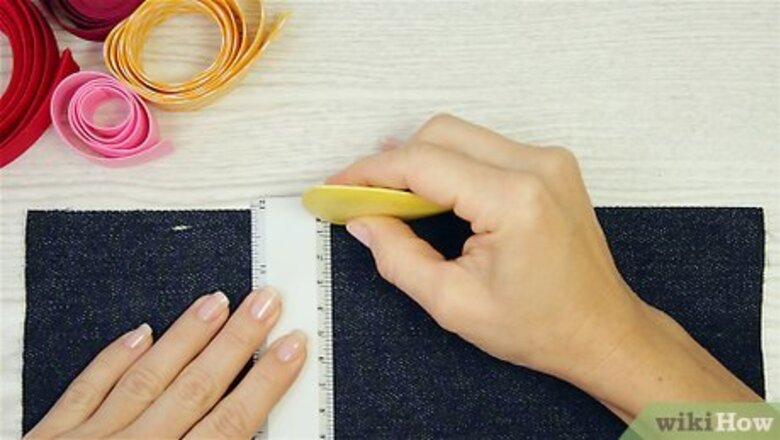
views
Sewing Single-Fold Bias Binding
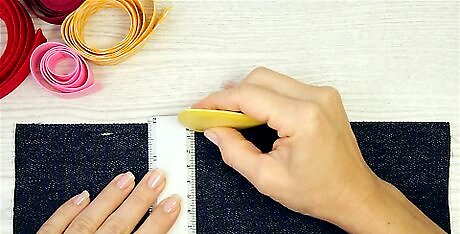
Mark your fabric where you want to sew the bias binding. The bias binding will need to cover the raw edge of your fabric, but placing it too close to the raw edge may result in a weak seam. To ensure a strong seam, you will need to place the edge of the binding slightly in from the edge of your fabric. Mark the fabric about 6 millimetres (0.24 in) from the raw (cut) edge to indicate where you will place the edge of the binding.
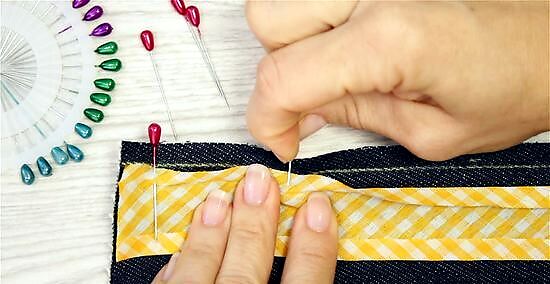
Pin the bias binding to the fabric. Unfold one edge of the bias binding, and line up the raw edges of the bias binding with the chalk line you have marked onto the fabric. The right (front) side of the bias binding and the right (front) side of your fabric should be facing each other. Insert pins through the bias binding and fabric to hold them together. Make sure to fold under the ends of the bias binding so that the raw edges will not be visible. You can also use clips to hold the bias binding in place. These will prevent you from making holes in the bias binding or fabric, which may be a concern especially if the fabric or binding are made from a delicate material.
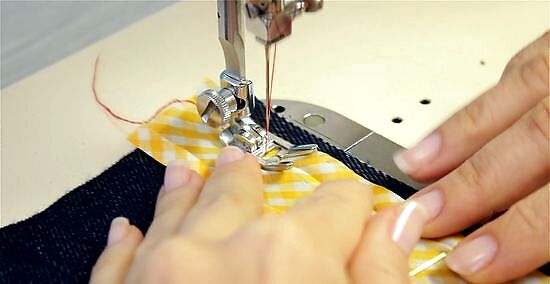
Sew along the crease of the bias binding. The bias binding should have folded edges that run the length of the binding. When you open the folds up, you will see that the binding has a crease. Use your sewing machine to sew a straight stitch into this crease to secure your bias binding and fabric together.

Press the binding over the seam allowance. After you have sewed the bias binding to the fabric, fold over the bias binding so that it covers the seam allowance of your fabric. Next, use an iron to press this seam and make the bias binding lay flat over the seam allowance. Use your iron on a low setting or one that is appropriate for your fabric. If you are worried about damaging the fabric, then place a t-shirt or cotton cloth over the fabric before you iron it.
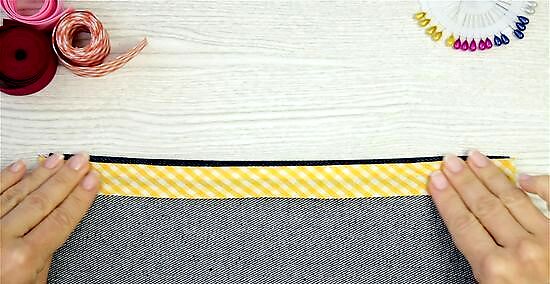
Fold the bias binding over to the other side of the fabric. Next, fold the bias binding over the edge of your fabric again. Fold the bias binding at the seam you created so that the bias binding will be completely hidden on the opposite side of your fabric.
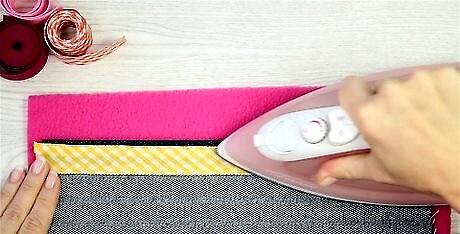
Iron the seam to flatten it. After you have folded the bias binding, use your iron to press the seam. This will help to keep the bias binding on one side of the fabric and create a nice neat edge for your work.

Sew along the other edge of the bias binding. To secure the bias binding, sew a straight stitch about 3 millimetres (0.12 in) from the edge of the bias binding. Use your sewing machine to do this. Make sure that the bias binding edge is folded under so that it will be hidden. After you finish sewing, trim off the excess threads.
Sewing Double-Fold Bias Binding
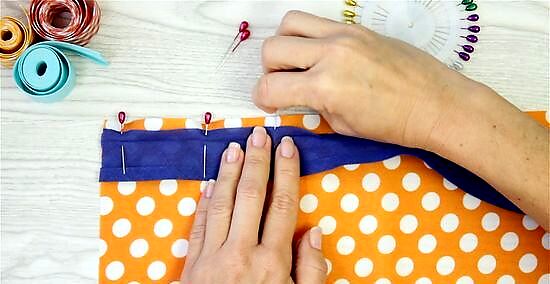
Pin the binding to the edge of your fabric. Line up the raw edges of your bias binding and fabric and pin the edges together. Make sure to unfold your bias binding first and pin the bias binding and fabric together so that the right (front) sides of the materials are facing each other. Make sure to fold and pin under the ends of the bias binding so that they will not be visible when you are finished.
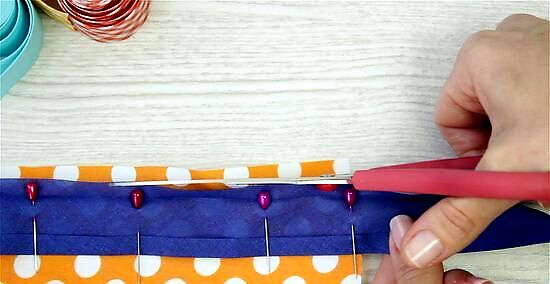
Trim off any excess fabric. If there is any excess fabric that goes beyond the edge of the bias tape, then trim this fabric off. Do not trim off any of the bias binding. Only trim off the fabric that extends past the edge of the bias binding.
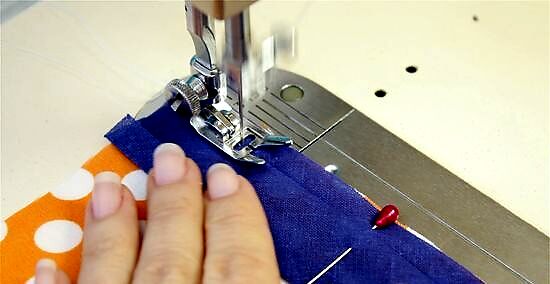
Sew along the crease. Locate the creased area of your bias binding. Use your sewing machine to sew a straight stitch down the length of the crease. When you get to the end, backstitch by a few stitches to secure the stitches. To backstitch, press the lever on the side of your sewing machine while you are applying gentle pressure to the pedal. After making a few stitches in the opposite direction of the others, take your foot off the pedal and remove the item from the sewing machine.
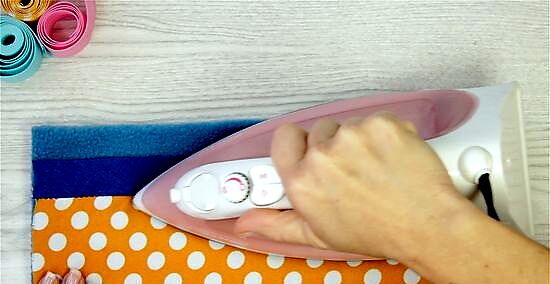
Press the seam allowance towards the binding. Next, fold over the bias tape so that it is covering the seam allowance. This is the raw (cut) edge of your bias tape and fabric. Use an iron to flatten out the seam.
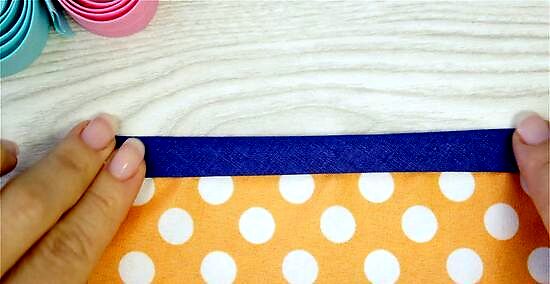
Fold the binding over so that half is on each side of the fabric’s edge. Then, fold over the bias tape again so that half of the bias tape is on each side of the fabric’s edge. Make sure that the free end of the bias tape is folded under to prevent the raw edge of the bias tape from showing.

Press the binding to crease the edge. To create a flat edge along the bias tape, use an iron to press along the folded fabric. This is the area that wraps around the edge of the edge of the fabric.
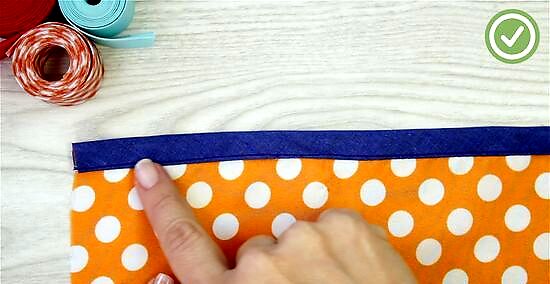
Sew along the edge of the binding. After you have pressed the edge, use your sewing machine to sew a straight stitch along the free edge of the bias tape. Make sure that the raw edge of the bias tape is folded under so that it will not be visible. Sew the stitch so that it is right along the edge of the bias tape.
Joining the Edges of Bias Binding
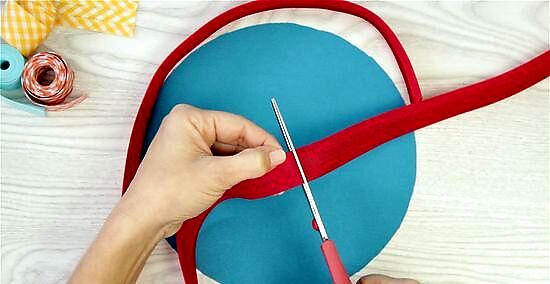
Cut about 1 inch (2.5 cm) more bias binding than you will need. When you cut your bias binding for the project, make sure that you cut a little more than you will actually need to cover the edges. This will allow you to sew the edges together in a way that will hide the ends of the bias binding. For example, if your project calls for 20 inches (51 cm) of bias binding, then cut 21 inches (53 cm) to ensure that you will have enough to hide the ends.

Join the ends before you sew the rest of the bias binding. Make sure to sew the bias binding edges first. You need to sew the ends under the rest of the bias tape to hide them, so it is necessary to secure and fold over the ends before sewing any other parts of the binding.
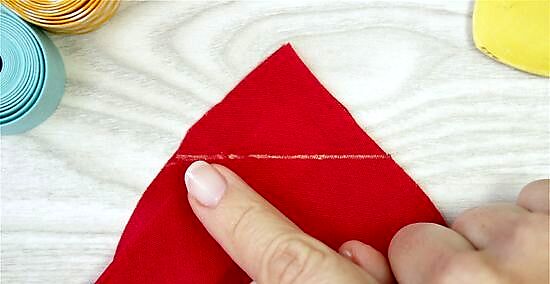
Pinch and mark the bias tape where the ends meet. The ends of the bias binding will be raw, so it is important to hide these. With the right sides of the bias binding and fabric together, pinch the ends of the bias tape together to identify where they will meet. Use a piece of chalk to mark the areas where the right (front) sides of the bias binding meet.

Pin the marked areas in place. After you have marked the bias binding, place a pin on each end to hold the pieces together where you marked them. Make sure the pin goes through the ends of the bias tape and the fabric underneath it.
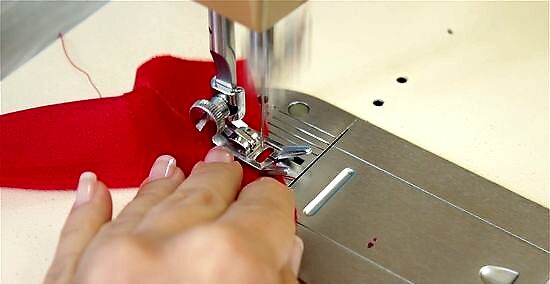
Sew a few stitches into the crease at each of the marks. To secure the bias binding together where you have marked it, use your sewing machine on the straight stitch setting to sew a few stitches into the crease up to the areas you have marked on each side of the bias binding. Do not sew across the bias binding pieces. Make two separate sets of stitches. Be careful not to sew through the pins and remove them as you sew.

Fold down the excess bias binding. After the bias binding is secured at the ends, fold down the excess bias binding on the ends. Fold each end towards the rest of the bias binding and away from the stitches you just made. This will ensure that the bias binding will be hidden under the rest of your seams.
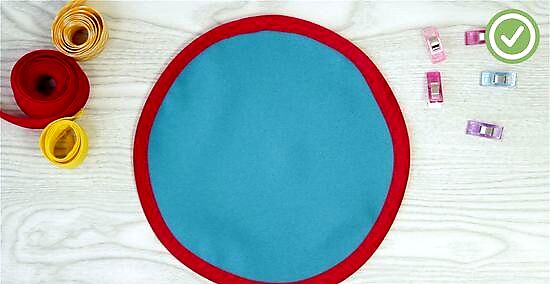
Sew the rest of the bias binding as desired for your project. After you finish securing the ends of the bias binding, sew the rest of the bias binding as desired for your project. You can either sew the bias binding single-sided, so that it will be hidden under one side of your project , or you can sew the bias binding double-sided so that half of the binding will be visible on each side of the edge of the fabric.



















Comments
0 comment